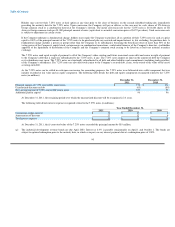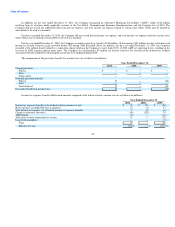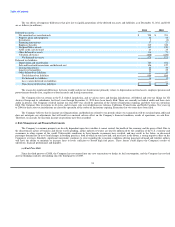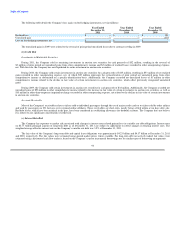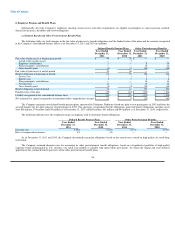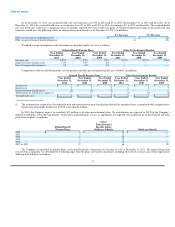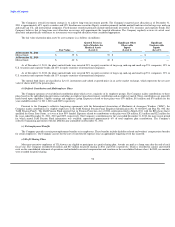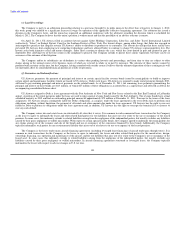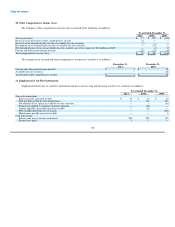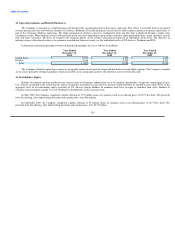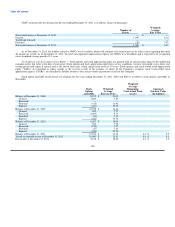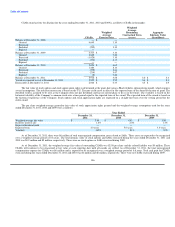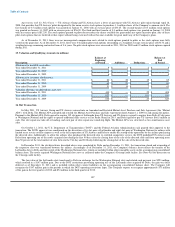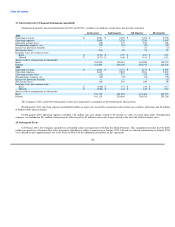US Airways 2011 Annual Report Download - page 103
Download and view the complete annual report
Please find page 103 of the 2011 US Airways annual report below. You can navigate through the pages in the report by either clicking on the pages listed below, or by using the keyword search tool below to find specific information within the annual report.
Table of Contents
(c) Off-balance Sheet Arrangements
US Airways has 36 owned aircraft, 114 leased aircraft and three leased engines, which were financed with pass through trust certificates, or EETCs,
issued by pass through trusts. These trusts are off-balance sheet entities, the primary purpose of which is to finance the acquisition of flight equipment. Rather
than finance each aircraft separately when such aircraft is purchased, delivered or refinanced, these trusts allowed US Airways to raise the financing for
several aircraft at one time and place such funds in escrow pending the purchase, delivery or refinancing of the relevant aircraft. The trusts were also
structured to provide for certain credit enhancements, such as liquidity facilities to cover certain interest payments, that reduce the risks to the purchasers of
the trust certificates and, as a result, reduce the cost of aircraft financing to US Airways.
Each trust covered a set amount of aircraft scheduled to be delivered or refinanced within a specific period of time. At the time of each covered aircraft
financing, the relevant trust used the funds in escrow to purchase equipment notes relating to the financed aircraft. The equipment notes were issued, at US
Airways' election, in connection with a mortgage financing of the aircraft or by a separate owner trust in connection with a leveraged lease financing of the
aircraft. In the case of a leveraged lease financing, the owner trust then leased the aircraft to US Airways. In both cases, the equipment notes are secured by a
security interest in the aircraft. The pass through trust certificates are not direct obligations of, nor are they guaranteed by, the Company or US Airways.
However, in the case of mortgage financings, the equipment notes issued to the trusts are direct obligations of US Airways. As of December 31, 2011,
$1.28 billion associated with these mortgage financings is reflected as debt in the accompanying consolidated balance sheet.
With respect to leveraged leases, US Airways evaluated whether the leases had characteristics of a variable interest entity. US Airways concluded the
leasing entities met the criteria for variable interest entities. US Airways generally is not the primary beneficiary of the leasing entities if the lease terms are
consistent with market terms at the inception of the lease and do not include a residual value guarantee, fixed-price purchase option or similar feature that
obligates US Airways to absorb decreases in value or entitles US Airways to participate in increases in the value of the aircraft. US Airways does not provide
residual value guarantees to the bondholders or equity participants in the trusts. Each lease does have a fixed price purchase option that allows US Airways to
purchase the aircraft near the end of the lease term. However, the option price approximates an estimate of the aircraft's fair value at the option date. Under
this feature, US Airways does not participate in any increases in the value of the aircraft. US Airways concluded it was not the primary beneficiary under
these arrangements. Therefore, US Airways accounts for its EETC leveraged lease financings as operating leases. US Airways' total future obligations under
these leveraged lease financings are $2.67 billion as of December 31, 2011, which are included in the future minimum lease payments table in (b) above.
(d) Regional Jet Capacity Purchase Agreements
US Airways has entered into capacity purchase agreements with certain regional jet operators. The capacity purchase agreements provide that all
revenues, including passenger, mail and freight revenues, go to US Airways. In return, US Airways agrees to pay predetermined fees to these airlines for
operating an agreed-upon number of aircraft, without regard to the number of passengers on board. In addition, these agreements provide that certain variable
costs, such as airport landing fees and passenger liability insurance, will be reimbursed 100% by US Airways. US Airways controls marketing, scheduling,
ticketing, pricing and seat inventories. The regional jet capacity purchase agreements have expirations from 2014 to 2020. The future minimum
noncancellable commitments under the regional jet capacity purchase agreements are $1.06 billion in 2012, $997 million in 2013, $995 million in 2014,
$854 million in 2015, $526 million in 2016 and $741 million thereafter. These commitments are estimates of costs based on assumed minimum levels of
flying under the capacity purchase agreements and the Company's actual payments could differ materially. These commitments include the portion of the
Company's future obligations related to aircraft deemed to be leased of approximately $300 million in 2012, $300 million in 2013, $290 million in 2014,
$250 million in 2015, $140 million in 2016 and $230 million thereafter.
100


